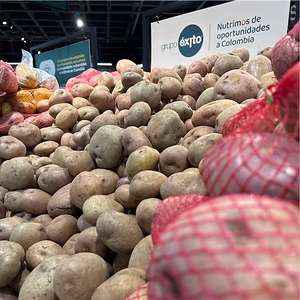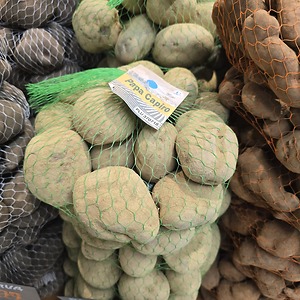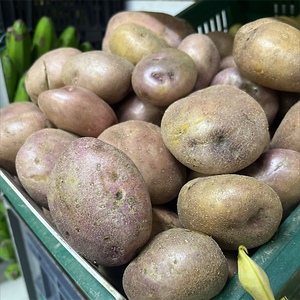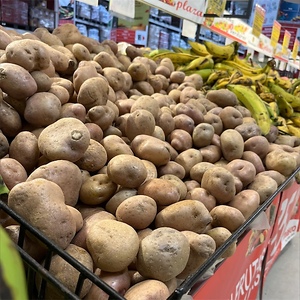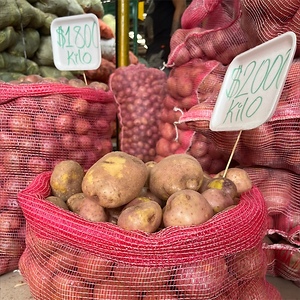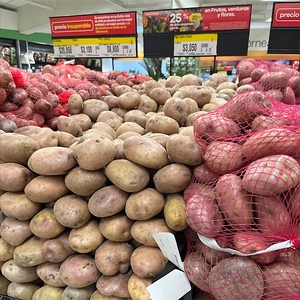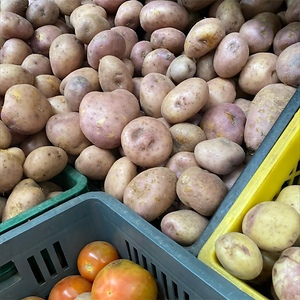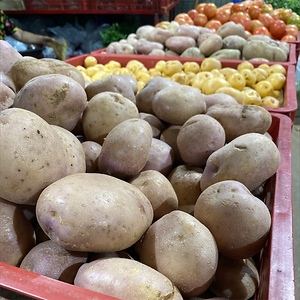

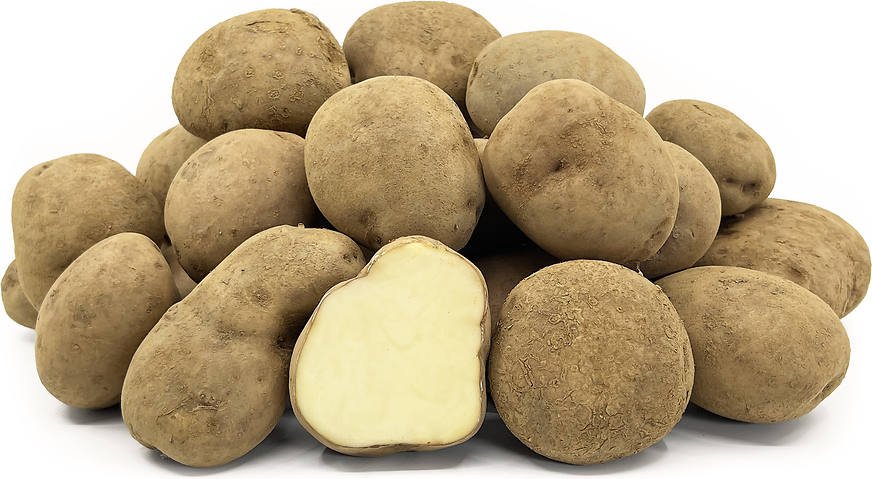
Capiro Potatoes
Estimated Inventory, lb : 0
Description/Taste
Capiro potatoes are a commercial varietal, averaging 6 to 7 centimeters in diameter and 7 to 10 centimeters in length. The tubers are generally uniform with a round, oval, oblong shape and have blunt, curved ends and a slightly flattened nature. When sold in markets, Capiro potatoes are often displayed with a layer of dirt covering the tubers. Once washed, the potatoes reveal variegated red, purple, and brown hues but are primarily red. The skin is also dotted with textured rough patches and shallow, superficial eyes and is semi-thin, taut, and tightly adhered to the flesh. Underneath the surface, the cream-colored to ivory flesh is dense, firm, and slippery when raw, softening into a thick, smooth, and creamy consistency once cooked. Capiro potatoes are edible cooked and have a mild, earthy, neutral, and subtly sweet taste.
Seasons/Availability
Capiro potatoes are available year-round.
Current Facts
Capiro potatoes, botanically classified as Solanum tuberosum, are a commercial variety belonging to the Solanaceae or nightshade family. The late-season tuber was developed in Colombia in the late 20th century and quickly became a favored cultivar for its high yields throughout South America. Capiro potatoes are known by several names, including ICA Huila, R-12, R-12 Red, R-12 Negra Industrial, Capira, and Diacol Capiro. Since their release, Capiro potatoes have been primarily cultivated for commercial processing, as they have a mild flavor and soft, fluffy texture suitable for frozen goods. The variety is considered dual-purpose and is also sold to markets for sale as an everyday culinary ingredient. Capiro potatoes are a productive variety, producing 40 to 70 tons of tubers per hectare, and the variety is grown throughout the Andean highlands as a commercial crop. In culinary preparations, the variety is promoted as a neutral, all-purpose cultivar for savory cooked dishes.
Nutritional Value
Capiro potatoes have not been extensively studied for their nutritional properties. Commercial potatoes, in general, are a source of fiber to regulate the digestive tract, phosphorus to repair cell tissues, and potassium to balance fluid levels within the body. Potatoes also provide some iron to develop the protein hemoglobin for oxygen transport through the bloodstream, magnesium to control nerve functions, vitamin C to strengthen the immune system, and other nutrients, including manganese, calcium, zinc, and vitamin K.
Applications
Capiro potatoes have a mild, neutral, subtly sweet, and earthy taste suited for cooked preparations. The variety is versatile in savory recipes and is typically used in fried, baked, or boiled preparations. Capiro potatoes hold their shape well and are often incorporated into potato salads. The tubers are also boiled and tossed with herbs and sauces as a simple side dish, cut into pieces and roasted, or sliced and layered into casseroles. In Colombia, Peru, and Ecuador, Capiro potatoes are commercially sold for use in soups, stews, and chowders. The variety can be used in locro de papa, a potato soup topped with avocado and cheese, mixed into ajiaco, a soup made from three types of potatoes, or chupe de camarones, a hearty dish of shrimp, potatoes, peas, and corn. Capiro potatoes can be left in large pieces or finely ground and combined into the base of the soup as a thickener. Cooked tubers can also be blended into a puree. One of the most famous uses for Capiro potatoes is their prevalence in commercial processing. The variety is made into frozen food items and is also used to make French fries. Capiro potatoes pair well with corn, legumes, bell peppers, carrots, celery, tomatoes, squash, aromatics such as chile peppers, garlic, and onions, meats such as pork, beef, poultry, and lamb, quinoa, rice, and spices including cumin, oregano, paprika, and cloves. Whole, unwashed Capiro potatoes will keep for 3 to 5 weeks when stored in a cool, dry, and dark location.
Ethnic/Cultural Info
Commercial potato varieties, including Capiro, are prevalently used in Colombia to make papas saladas or salted potatoes. In the dish, potatoes are boiled in salted water until the water evaporates, leaving a salty crust. The salt-crusted tubers date back to at least the 18th century, and it is hypothesized the dish arose from salt mine workers who once cooked wild potatoes in salted water. Some also believe the dish may stem from simple preparations made by farmers. Despite its murky origins, papas saladas became a favored side dish in Colombian gastronomy as the salt creates a crusted, flavorful coating on the outside of the tubers. The potatoes can be halved and stuffed, served simply with fresh herbs, eaten with roasted meats, or incorporated as a base flavoring in other dishes. In Bogotá, papas saladas are famously served with roast chicken. Beyond everyday preparations, potatoes are curiously used in a New Year's Eve tradition in Peru and Colombia. Three potatoes of a similar size and shape are gathered, and one is left intact, one is peeled halfway, and the other is peeled entirely. In Peru, the potatoes are placed under a couch or chair, while in Colombia, the tubers are hidden under a bed pillow. At midnight on New Year’s Eve, one of the potatoes is blindly picked, and the tuber chosen is said to predict prosperity and financial fortune in the year to come. The intact potato represents wealth in the new year, the half-peeled represents an average year, while the peeled potato symbolizes a poor financial year or an unpredictable year.
Geography/History
Capiro potatoes are believed to be native to Colombia and were developed by the Colombian Agricultural Institute, ICA, in the mid to late 20th century. The variety was created from a cross between a potato named 1967, also known as CCC751, and Tuquerreña, known as CCC 61. Capiro potatoes were commercially released in 1968 and were promoted as a processing variety and as a tuber for direct fresh sales. The cultivar quickly became a favored potato throughout South America and is typically grown between 1,800 and 3,200 meters in elevation. Today, Capiro potatoes are cultivated throughout Colombia, especially in the departments of Cauca, Caldas, Cundinamarca, Antioquia, Santander, Tolima, Boyacá, and Nariño. The variety is also cultivated throughout northern and central areas of Ecuador, in the highlands of Peru, and in parts of Venezuela. The Capiro potatoes featured in the photograph above were sourced through the districts of Surquillo and Miraflores in Lima, Peru.
Recipe Ideas
Recipes that include Capiro Potatoes. One
| Kristine's Kitchen |
|
Best Creamy Potato Soup |
| The Kitchen is My Playground |
|
Kielbasa Potato Soup |
| Cooking LSL |
|
Easy Lentil Potato Soup |







